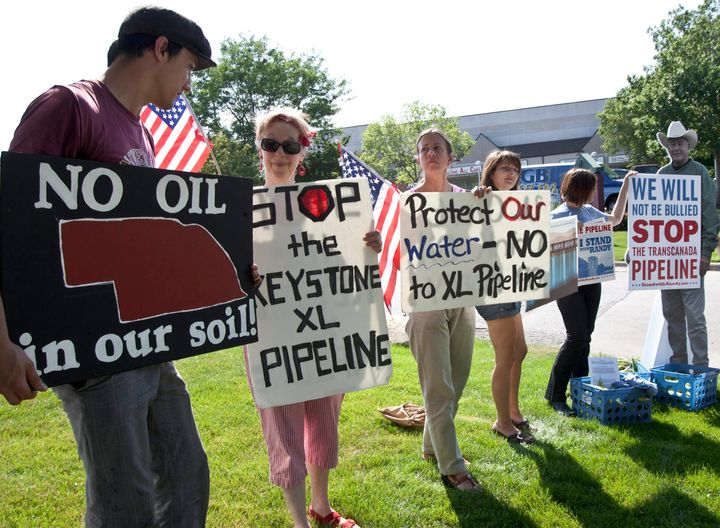
Remember "the death of environmentalism"? A funny thing happened on the way to the funeral. The environmental movement hasn't been this energized, engaged, and relevant since 1970, when 20 million people celebrated the first Earth Day, Richard Nixon created the Environmental Protection Agency, and Congress overwhelmingly passed the Clean Air Act. Those three events marked the birth of the modern environmental movement and, four decades later, they still reverberate as it faces both its greatest challenges and its most exciting opportunities.
In 2011, the environmental movement rediscovered that its most valuable asset is the spirit that brought millions of ordinary people together at that first Earth Day. Whether you call them tree-huggers, do-gooders, or Americans, it is these millions of ordinary people who refuse to succumb to cynicism and apathy that remain the heart and soul of this movement.
Nowhere was that more evident than during November's massive protest outside the White House to urge President Obama to reject the 1,700-mile tar-sands pipeline, which would carry dirty oil from Alberta to the Gulf of Mexico. As with other populist movements this year, from the Arab Spring to Occupy Wall Street, the protest against the Keystone XL pipeline was provoked by a deep sense of injustice. I watched with a mixture of pride and awe as more than 12,000 people, young and old, from every walk of life and from every part of the nation, came together to hold a president accountable to his own principles. Fortunately, the man in the White House got the message.
Last summer, I listed stopping the Keystone XL as one of four major decisions facing President Obama that would test his environmental commitment. Two of the others were important clean-air standards expected from the Environmental Protection Agency. EPA Administrator Lisa Jackson was able to get one of them across the finish line -- the first-ever standard for how much mercury and other toxic emissions we allow power plants to pump into the air we breathe and water we drink. This rule will prevent hundreds of thousands of illnesses and up to 17,000 premature deaths each year.
On the other clean-air standard, though, the president made a serious mistake by allowing the postponement of an important rule to protect the public by strengthening safeguards against smog pollution.
President Obama's fourth decision was on how ambitious to make new fuel-economy and emission standards for cars and light trucks in 2025. This time, the administration came through, with a strong standard of 54.5 mpg that will save consumers money, significantly decrease carbon pollution, and do more than any other measure to wean us from our dependence on oil.
So on those big issues, we scored three out of four with Obama this year -- not a bad record for a movement that supposedly was being ignored or taken for granted by the president. The most exciting success story of the year, however, required no help from the president or Congress. It couldn't have happened without the Clean Air Act, though.
Although our air has gotten significantly cleaner since 1970, a shocking amount of pollution still makes it dirtier and unhealthier than it should be -- and coal-fired power plants are the biggest culprit. The Sierra Club's campaign to move Beyond Coal began almost ten years ago, but it really took off in 2011. Although we got a gigantic boost this year when the Bloomberg Foundation committed $50 million, the campaign is still driven at its heart by the grassroots energy of people who live in the shadow of polluting coal-fired power plants and can see for themselves how it's sickening their children and blighting their communities. By year's end, we secured the retirement of almost 90 dirty, outdated coal plants, and defeated more than 160 proposed new plants. That doesn't sound like an ineffective movement to me.
Of course, stopping coal wouldn't be possible if we didn't have something better to offer. Fortunately, clean renewable energy sources are taking off in spite of attempts by the fossil-fuel apologists to pretend otherwise. When government red tape made it impossible for SolarCity to secure a federal loan guarantee for its project to install rooftop solar panels on military housing across the country, it looked like a huge missed opportunity -- the chance to provide clean energy to 120,000 homes. In fact, it was too good an opportunity to miss. The program will move forward with private financing, bringing not just clean solar power but jobs for thousands of vets and military families. That's just one of the many clean-energy success stories this year, but there will be even more to come. By 2020, clean-energy investments will create as many as 1.9 million jobs nationally.
Believe it: This movement is stronger than ever. More importantly, it will keep gaining strength for a simple reason: Its core values -- fairness, justice, and responsibility -- are shared by the majority (let's say at least 99 percent) of people everywhere.
